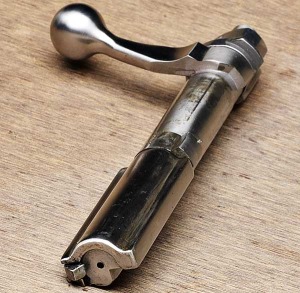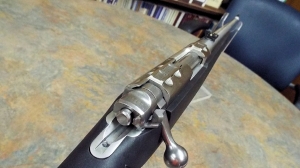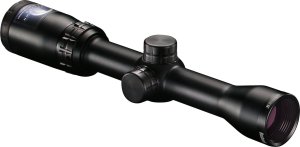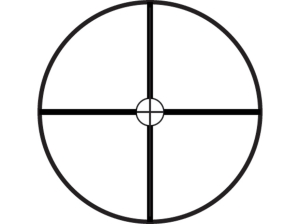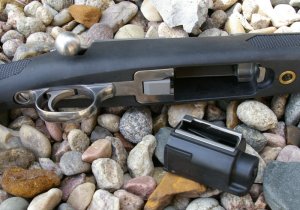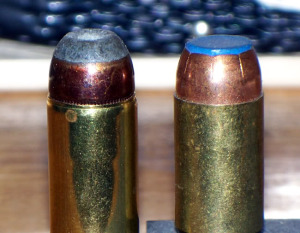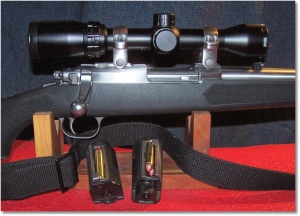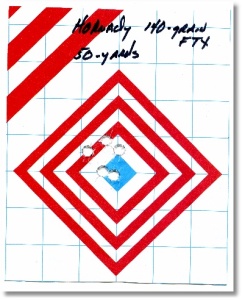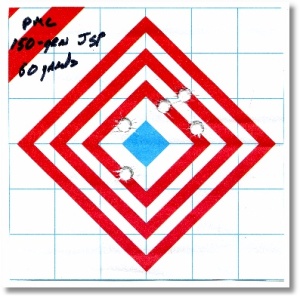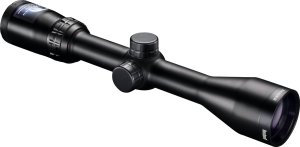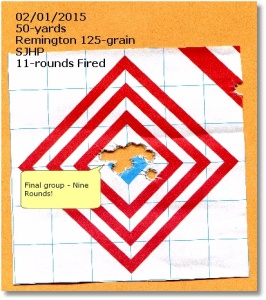Author’s Note: Not long after this article was written, the entire series of M77 rifles was discontinued by Ruger due to low sales. The .44 Magnum version was the first to go, was soon followed by the .357 Magnum, and shortly thereafter followed by the .17WMR and .22WMR calibers. This is unfortunate, but this is also business. Ruger M77 rifles can still be found; however, through on-line sales and auction sites, for the time being at least. It is unfortunate to see these pistol-caliber carbines fade into history, like so many others before them.
“Ruger Introduces The 77/357
June 22, 2011
Sturm, Ruger & Company, Inc. (NYSE: RGR) is proud to announce the Ruger® 77/357™, a lightweight, bolt-action rifle chambered in the venerable .357 Magnum and fed via a rotary magazine.
The bolt-action 77/357 features a five-round rotary magazine and is offered in the Ruger All-Weather® configuration, which includes a durable, weather-resistant stainless steel barrel and receiver and a rugged, black composite stock. Although it is fitted with fully adjustable iron sights, the 77/357 also ships with patented Ruger scope rings, allowing a variety of sighting options for this lightweight (5-1/2 pounds), quick-handling rifle.
“The 77/357 is an effective tool for hunting medium-sized game – especially in heavy cover,” said Bruce Rozum, Chief Rifle Engineer at Ruger. “Bullet velocities of .357 Magnum ammunition increase significantly when fired out of the 77/357’s 18 1/2″ cold hammer-forged barrel. In testing, Hornady® 140 grain FTX® loads were clocked at over 1820 feet per second. Furthermore, the flush-fit, four-shot rotary magazine does not protrude at the rifle’s balance point and, unlike tube-fed rifles, the Ruger 77/357 can be readily loaded and unloaded,” he concluded.”
The first introduction that I had to .44 magnum carbines was the Ruger Model 44 that was produced from 1961 until 1985. I was big into magnum firearms at the time and a used Model 44 was added as a companion to my Iver Johnson 44 magnum “Cattleman” revolver – a revolver that nearly took my head off, but that’s another story for a later time.
The Ruger Model 44 was based on the military M1 Carbine. What resulted was a short-barreled carbine on .44 magnum steroids. I like it a lot although it kicked like a mule. I later had to sell it due to a deployment overseas. It is one of the few guns that I missed over the years. I have seen them since at gun shows but passed on them after looking over the price.
When Ruger came out with the bolt-action M77/44 in 2009, I became interested in it but soon dropped interest simply because I had lost my desired to be hammered by a short carbine, although it would be a nice companion to the Ruger Redhawk in the same chambering.
In 2011, Ruger introduced the 77/357 (Model 7405) and, again, I wasn’t interested although my SP101 and GP141 could have used a nice companion. Rather than a bolt-action rifle capable of chambering the .38 special/.357 magnum cartridge, I turned to a lever-action Rossi R92 in a 20” round-barreled version. At first, the Rossi seemed to perform just short of correct and spiraled downhill from there. More jams than necessary when attempting to cycle .357 magnum ammunition degraded to extraction problems with both .38 special and .357 magnum ammunition. Essentially, I had a single-shot rifle with a lever attached. The rifle was traded for the Ruger Gunsite Scout, which is a really great bolt-action carbine chambered in the ever-popular .308 Remington cartridge and the 7.62x51mm NATO cartridge and I soon became more cognizant of the 77/357 rifle’s existence and pondered until I was weak and weary over whether the 77/357 was destined for a home.
I started my research, beginning with Jeff Quinn at Gunblast.com (http://www.gunblast.com/Ruger-M77-357.htm) and that led me to more research on various forums and watching quite a few videos, which subsequently sent me to local gun shops in a quest to at least hold the darn thing. My first impression was that it was a 10/22 on steroids, and rendered as a bolt-action carbine instead of semi-automatic. What I did like was the simplicity of the 77/357 rifles design. I’ve always been a bolt-action person, favoring them over other actions – yeah, even semi-automatics.
One of the first things that I noticed about the rifle was the usual Ruger “overbuild” even though this rifle only weighs in at about 5.5 pounds dry. The bolt has a solid feel to it as it is cycled through its sequence. Brand new, the bolt feels somewhat gritty but after proper lubrication that will go away. New and out of the box, the trigger broke pretty clean between 4.25 and 5.50 pounds. Again, some good lubricant and use will smooth it out.
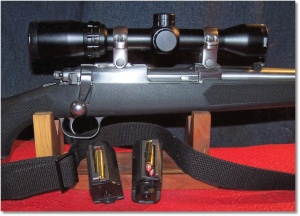
Bushnell Banner Dusk & Dawn Circle-X Reticle Riflescope, 1-4X 32mm Mounted. Ten rounds of Hornady 140-grain FTX at the Ready. Note that the SKS sling works perfect on this carbine
Length of pull is at 13.5 inches. While I prefer a 14.5-inch LOP, the M77/357 feels right for me and comes to the shoulder quickly. Looking down the barrel, Ruger provided a flip-down diamond rear sight with a brass bead front sight. I don’t see changing them out any time soon. For optics, Ruger provides a set of forged stainless steel rings and three mounting slots milled into the receiver. I have ordered the Bushnell Banner Dusk & Dawn Circle-X Reticle Riflescope, 1-4X 32mm for it, which I feel will be more than enough for this little carbine should I need to use optics. UPDATE: With the Bushnell Banner Dusk & Dawn Circle-X Reticle Riflescope, 1-4X 32mm mounted, the 90-degree bolt handle just does clear the bell of the scope,
The safety is a rear-mounted three-position unit and is readily accessible by either left or right handed shooters. The bolt system itself is somewhat different in that it locks in the rear of the bolt rather than in the front. The bolt’s cocking piece serves as a “loaded’ indicator and also serves as a resting place for the safety when in the “Full safe” mode.
The rotary magazine holds five rounds, which provides a total of 6 rounds available to the operator (with one chambered). The only negative reports that I had read on the rifle was the operation of the magazine. Only time and use will tell if that continues to be a problem or if Ruger has rectified the situation with later production magazines. The downside to the magazines for this rifle is the cost factor. Since these magazines are Ruger-proprietary units, the cost of the magazines are higher than one would like – but that’s the nature of the beast. I have found them on-line for cheaper than I can buy them at my LGS, but by the time shipping is paid on them, all things become equal. I purchased two additional magazines at the time of purchasing the rifle and will add two more for a total of five; the rifle comes with one magazine. (Note: See the range report)
On this particular rifle, the magazine drops out and inserts in easily. When the forward section of the magazine latch is pushed in (pivoted upward), the magazine is released. One way of removing the magazine is to cradle the rifle in the left hand with the palm under – but not against – the magazine. Use the right forefinger to fully depress the magazine latch and the magazine will drop free. Another way (illustrated) is to press the latch with the thumb and at the same time grasp the magazine between the thumb and forefinger and draw it out of the gun. The magazine fits flush against the rifle and does not detract from the rifle’s looks or interfere with the operator.
Getting to the heart of the matter – performance. The .357 has proven its potency as a defensive round when fired from revolvers. By chambering this cartridge in a bolt-action rifle, the longer barrel gives the powder more time to burn, and the closed breach prevents the pressure loss caused by a revolver’s cylinder gap. The result is a measured increase in velocity that brings the .357 Mag. in line with other cartridges appropriate for the taking of medium and small game. In fact, it is stated that ballistics of the .357 should come close to the .30-30 in power factor at short range. Either a 125-grain defensive load or a 158-grain SJSP should do well.
The 77/357 presents itself as a handsome, lightweight carbine ready to roll out as a ranch gun, a low-recoil training gun, a practical plinking piece, or a scoped hunting rifle for medium and small game. The rifle’s carbine configuration and all-weather construction also make it an ideal choice as a camping or survival rifle. Ruger’s American-made M77/357 rifle demonstrates the same level of fit, function, and reliability as the company’s rifle-caliber models.
It is also a great companion to the Ruger GP100 in any length and would make a “woods walk” doubly safe, because one does not know anymore what ‘animal’ is lurking. Since the 77/357 and the GP100 uses the same ammunition, they become a compatible pair to have around the homestead.
I’ll soon be taking it to the range to see if it performs as well as it looks.
Range and Operations Report:
Let’s just say that the range session with the Ruger M77/357 did not go as pleasantly as expected. However, I did learn a lot from the session.
I had chosen four manufacture’s of .357 magnum ammunition with which to evaluate the M77/357:
- Georgia Arms 125-grain JHP
- PMC 185-grain JSP
- Remington 125-grain JHP
- Hornady Leverevolution 140-grain FTX
Also, in preparation for the range session, I had:
- Pre-loaded 5 Ruger 357 rotary magazines.
- Mounted the Bushnell Banner Dusk & Dawn Circle-X Reticle Riflescope, 1-4X 32mm in the rings provided by Ruger, bore-sighted the rifle, and then removed the scope to be re-installed at the range (I wanted to fire the rifle with open sights before I installed the scope permanently).
The first problem arose at the range – lack of a stable platform from which to shoot. There was a table, but no means to sit at the table. I needed to bench rest the rifle to zero the scope. This is what happens when you don’t have your own range. Talking with the folks at the range, we came up with a suitable stool and rifle forearm rest. Shaky at best, but leads into shooting excuse #1.
I was going to set zero for 50-yards with the scope, but I wanted to use open sights to see if I could use the open sights, which leads into shooting excuse #2. While the sights are adequate on the M77/357, they were not adequate for my eyes that need a new prescription. Regardless, I made a SWAG as to the sight alighnment and managed to pull of a 5-inch group; albeit high on the target. I dropped the front sight into the notch in the rear sight a bit (as best as I could determine) and the second magazine of 5-rounds found its mark closer to the center than before.
So far, ten rounds were fired; eight of which were misfeeds. The Georgia Arms 125-grain JHP ammunition was hanging up on the feed ramp. Great, I thought! All of those posts that I had been reading about magazine malfunctions were true.
I decided to switch ammunition and try some of the PMC 185-grain JSP. The results were the same – many misfeeds. I decided, at that point, to try and get the scope zeroed with the PMC ammunition. Mounting the scope went quickly, because all I had to do was install the scope on the rifle and then tighten the base screws.
The rest was shaky, the table was shaky, the chair was shaky, the trigger was heavy, and I was shaking from too much caffeine and not enough breakfast (poor shooting excuse #3). Once the scope was mounted, I set out to zero everything. That’s when I realized that the rifle/scope setup was amiss. The eye relief with the Bushnell Banner Dusk & Dawn Circle-X Reticle Riflescope, 1-4X 32mm was too long; I had to either scrunch up and pull the rifle deep into my shoulder or extend my neck to the point that it was uncomfortable. However, I was bound and determine to make this work even if it was wrong, which is why I have poor shooting excuse #4 and #5.
I went through the box of fifty rounds of PMC 185-grain JSP and manage to wring out a couple of 1.5” groups at fifty yards. There is nothing wrong with the Ruger M77/357 accuracy wise. I was hoping to find the right timing with the bolt to maybe overcome the feeding issue, but that was not going to happen any time soon. One thing good about the Ruger M77/357, the magazine can be filled from the top of the rifle, and I had to do this on several occasions. Somehow, I bit the bullet (I actually did dent the case on one round) and made it through.
The recoil on this rifle is not enough to write home about. The light recoil would make the rifle suitable to a wide variety of folks including those who are recoil sensitive.
Some might find the LOP a little much. Ruger claims a 13.5-inch LOP, but I measured the LOP at 13.75 inches. At a total length of 38.5 inches, the M77/357 is nicely balanced and at 5.5 pounds it is very light.
I switched to the Remington 125-grain JHP and knew that I would have to re-zero the rifle. That is no problem with the Bushnell Banner Dusk & Dawn Circle-X Reticle Riflescope, 1-4X 32mm; the turrets are finger adjustable and move quite easily. It took me two magazines to realize that I had not had a feeding issue. Wow! Maybe it wasn’t the magazines after all. I shot twenty-five rounds with no problem. So, I moved on to the Hornady ammunition.
The Hornady Leverevolution 140-grain FTX worked flawlessly with the M77/357 and I decided to re-zero the scope with this ammunition. With both the Remington 125-grain JHP and the Hornady Leverevolution 140-grain FTX, I was able to get several 1.5” groups with no misfeeds at all. The day was getting better. I would find out why when I got back to the house.
I pulled some new ammo for each manufacturer when I got home to see what the differences were between the ammunition. Obviously, the Hornady Leverevolution 140-grain FTX ammunition with its “flex-tip” was a little bit different from the rest – but not that much different. The real different was in the case.
The Georgia Arms 125-grain JHP and PMC 185-grain JSP cases were taper-crimped. The Remington 125-grain JHP and Hornady Leverevolution 140-grain FTX case; however were roll-crimped. Therein, I believe, lays the difference between feeding and not feeding. The roll-crimped cases simply slid past the feed lip and allows the bolt to position the round correctly for chambering. The taper-crimped case could not get past the feed lip and jammed the bolt. When they did get past the feed lip, they were forced to low for the bolt to work properly, which led me to back off the bolt a bit and allow the round to correct itself – or I had to correct it myself manually.
With the M77/357 on safe, I commenced to run the bolt on 50 rounds of the Remington 125-grain JHP and twenty-five rounds of the Hornady Leverevolution 140-grain FTX case. I did so without one problem feeding the beast. The Hornady Leverevolution 140-grain FTX case was the slicker of the two and chambered like a hot knife through butter.
If you are considering adding the Ruger M77/357 to your stable, consider using ammunition only with roll-crimping. Or, if you are a hand-loader, roll crimp your hand loads. While a taper-crimp may work fine in revolvers, it does not work fine in rifles trying to chamber that load, at least, not in the Ruger M77/357. I read somewhere that Ruger recommended the Hornady Leverevolution 140-grain FTX ammunition. Now, I see why.
With that solved, it was time to look at the scope. The Bushnell Banner Dusk & Dawn Circle-X Reticle Riflescope, 1-4X 32mm is a fine scope but it is better on a rifle/shotgun with a short LOP. The 14-inch LOP on the M77/357 is fine for me, but the scope was not the correct one for the rifle. My bad!
Since I had to make a quick trip to Wal-Mart, I went to Sporting Goods while I was there. I had measured the scope mount distance before I had left (just in case) and layed the measuring tape alongside several scopes. The winner was the Bushnell Banner Illuminated Red/Green Multi-X Reticle Riflescope, 3-9x40mm. I did not know if the 40mm objective lens would clear the rear fixed (fold down) sight on the M77/357, but it was worth a try (Ruger does make a set of high scope rings for the rifle). Even though the scope has an illuminated reticule, I rarely use the illumination.
When I got home, I quickly mounted the scope with the help of the Wheeler Engineering Fat Wrench (30-inch pounds on the base and 20-inch pounds on the rings) and the Wheeler Engineering level-level-level. I did have to move the rear scope mount to the farthest position on the rifle to balance the scope, but the result was worth it. The objective lens cleared the rear sight on the rifle and the eye relief was nearly perfect for me.
The Bushnell Banner Dusk & Dawn Circle-X Reticle Riflescope, 1-4X 32mm is not going to be relegated to the closet, however. I just happen to have a MSR that it should work on just fine. Since the MSR stock is adjustable, the eye relief problem that was on the M77/357 will not exist on the MSR.
Range Update:
With the problems occurring during the first range session, it was time to return to the range with the Bushnell Banner Illuminated Red/Green Multi-X Reticle Riflescope, 3-9x40mm and some different ammunition.
Unfortunately, the eye-relief problem was still present, but the range results were better.
The trigger felt better; albeit still heavy, during this session. I have already talked to my favorite gun smith and he guaranteed a 3.5-pound trigger for me when he gets it in next week.
I was zeroing the rifle with Remington 125-grain JSP and has taken some PMC 150-grain JSP and a bit of Hornady 140-grain FTX Leverevolution for comparison.
Essentially, the feeding problems went away with all of the ammunition used but a few problems still persisted with feeding; however, it was much better than before.
At 50 yards I was able to put in a nice group with the Remington 125-grain JSP. I loaded up the Horndy 140-grain FTX Leverevolution ammunition, rezoered the rifle to this ammunition and pulled off a nice group of five round comparable to that of the Remington 125-grain JSP. The worst of the lot was the PMC 150-grain JSP. I tried to zero the rifle with this ammunition, but its performance was very erratic. Shooting a magazine of five rounds resulted in a poor group. For me, PMC 150-grain ammunition won’t be used again. Luckily, I do not have a lot of this ammunition and can relegate it to ’emergency’ use only.

Bushnell Banner 3-9×40, 6″ Eye Relief Scope Mounted and Ready to Go. Although the objective lens housing Look like it is hitting the rear sight, it is not and there is plenty of clearance. Also note the length of the ocular lens housing, which provides the 6″ eye relief
As far as the scope, I decided that a L.E.R. scope would be the best route to go and a Bushnell Banner Dusk & Dawn Multi-X Reticle Riflescope with 6-Inch Eye Relief, 3-9X 40mm has been installed since this write-up. This scope has taken care of the eye-relief problem. The Bushnell Banner Illuminated Red/Green Multi-X Reticle Riflescope, 3-9x40mm has an eye-relief of 3.1-inches and that was just not working for me with this rifle, although it may be an excellent scope for the AR – where I can adjust the stock to provide the correct scope picture.
I will say that the Ruger scope rings are good and place the ocular lens right where I need it to be; there is no need for a cheek rest.
I was well-pleased with this range session. The Ruger M77-357 is very accurate with the right ammunition. Hopefully, the feed issue will correct itself as the rifle breaks in.
If you are interested in the Ruger M77-357, and would want to scope it, the bolt may slide against the side of the ocular lens housing. I noticed some scraping on the ocular lens housing when I was putting the rifle in the case. It is not a game stopper; however, as no damage is done to the scope and the bolt operates freely. A 70-degree bolt would have been better to use on this rifle, which would allow better scope-to-bolt handle clearance.
Ruger M77/357 Range Update 02/01/2015:
Now fitted with the Bushnell Banner 3-9×40 Scope with 6-inch eye relief, the Ruger M77/357 is stating to show what is made of. The 6-inch eye relief is near perfection for me; close my eye, lay my head against the comb of the stock, open my sighting eye (left), and there is the cross-hairs of the scope. I could not ask for better. A minor cheek-weld adjustment, line up the cross-hairs on the target and I’m ready to go.
The Remington 125-grain SJHP was used to zero the new scope to the rifle.
Looking at the picture, the first shot in the upper right hand corner was the first shot fired for zero at 50 yards from as best a bench rest as I could make one. As you can see, the first, cold-barrel shot was low and left on the center diamond. Up to this point, I had made a rough bore-sight effort and knew that I was going to be low on the target, but I did know by how much.
I re-zeroed the rifle on this first shot (I know some say shoot a 3-shot group, but I feel that the first cold-bore shot is the most important). I decided to go for broke and set the sights on the lower diamond with the scope at 5x magnification – aim small, miss small. I loaded a fresh round into the magazine, which would give me ten rounds to get it right (a challenge to myself).
The trigger pull had come down to a little over five pounds, due to the two previous sessions. Before I decided to push the gun to my favorite and certified gun smith, I wanted to see how the rifle would do with the 5-pound pull first. If the rifle shot well, I would leave it at 5-pounds. If not, the trigger would be worked on.
I steadied myself for that next round after initial zero. The result was the hole to the lower-right of the group. Another zero adjustment produced the group you see above and to the left of it.
Slow fire and allowing the barrel to cool a bit between rounds produced (I think) excellent results. The group is not sub-MOA. Heck, it is not even MOA, but it is close enough for Government work with a utility rifle. That group is nine rounds. At that point, I put the turret caps on the scope, ran a Bore Snake through the bore, bagged the Ruger M77/357, and called it a day.
As a side note, I had a problem with the bolt handle hitting the previously-mounted scope. With the Bushnell Banner 3-9×40 with 6-inch eye relief scope, no scraping occurred and bolt handle clearance was fine.
The trigger is still too heavy for precision work, but the Ruger M77/357 is not a precision rifle. It is; however, one fine bolt-action utility carbine that I am happy to add to the stable. Regardless, the rifle will be going to my favorite and certified gunsmith tomorrow for a better, lighter, and smoother trigger.
I did have two FTFs in eleven rounds; one of which I attribute to my bolt handling while the other is unknown. While some might say that zero-tolerance for FTFs apply, I think that in this case (and since this carbine is a sporting rifle and not ‘intended’ for defensive use, the happenstance FTFs is accepted at this time. The number of FTFs has been reduced dramatically from the first outing with this rifle and seems to be more ammunition-related than anything. With that said, I am going to polish the feed ramp a bit to help negate any further FTFs. Then again, perhaps use will make the FTF issue go away.
The Ruger M77 series in any caliber (.44 magnum, .357 magnum, .22 (LR, WMR, or Hornet), or .17 caliber) would make a fine addition to the gun store for anyone seeking a good utility/survival/defense carbine. It has plenty going for it; price, quality, and accuracy (at least out to fifty yards that I can attest to).
Wrapping it up:
The Ruger M77/357 has turned out to be a proven performer with the right ammunition. The bolt is quick, extraction is perfect, and the form and fit of the rifle is excellent.
A better trigger would be nice, but I’m going to give this one a chance to break in before I decide to have it tuned. I wish that Ruger had come up with a magazine release system like that on the 10/22; the magazines can be a little persnickety to remove at times.
The fixed sights were useless to me, but did get me in the general direction of what I wanted to hit. Perhaps, after I get some new spectacles, I may change my mind about the sights. For now, a scope will do just fine.
I would like to see a 70-degree bolt handle like that on the Ruger American. The 90-degree bolt will contact the ocular lens housing when operated like it should be.
The Ruger M77/357 is neither a battle rifle nor a target rifle, but it would be an outstanding utility rifle; one used for survival, hunting, home defense, or just as a companion to a good .357 magnum revolver. I like the 125-grain JHP ammunition for the revolver, but if I can find 158-grain with roll-crimped cases that feed 100% of the time, I may go with that in the M77/357. Until then, the Remington 125-grain JHP is my first choice with the Hornady Leverevolution 140-grain FTX has my second choice; albeit, an expensive one.
If you like bolt-action rifles and the .357 magnum cartridge, the M77/357 might just fit the bill for the home or prairie companion. While I didn’t fire any .38 special ammunition, the M77/357 is more than capable of doing so.

RESOURCES:
- For more information, visit http://ruger.com/products/rotaryMagazine77357/models.html
- For information about the Bushnell Banner Dusk & Dawn Circle-X Reticle Riflescope, 1-4X 32mm, visit http://www.amazon.com/gp/product/B00IYHG2LM/ref=oh_aui_detailpage_o07_s00?ie=UTF8&psc=1
- For information about the Bushnell Banner Illuminated Red/Green Multi-X Reticle Riflescope, 3-9x40mm, visit http://www.amazon.com/Bushnell-Illuminated-Multi-X-Riflescope-3-9x40mm/dp/B000X7AK3C/ref=sr_1_18?s=sporting-goods&ie=UTF8&qid=1421622225&sr=1-18&keywords=Bushnell+Banner
- For information regarding the Bushnell Banner Dusk & Dawn Multi-X Reticle Riflescope with 6-Inch Eye Relief, 3-9X 40mm, visit: http://www.amazon.com/gp/product/B00J65GCYI/ref=oh_aui_detailpage_o00_s00?ie=UTF8&psc=1
- Note that the SKS sling in black is no longer sold by Amazon; Blackhawk 1″ sling mounts are available at Wal-Mart and other retailers.
- For Hornady Leverevolution 140-grain FTX, visit http://www.hornady.com/store/leverevolution_handgun
- For sight options, consider reading http://www.majorpandemic.com/2011/10/ruger-77357-7744-and-7722-sight-options.html
- A more succinctly written review can be found here: http://blog.cheaperthandirt.com/rugers-357-carbine/
- Ruger 77 Rifle in .357 Magnum : Gun Review: http://www.ammoland.com/2016/08/ruger-77-rifle-357-magnum-gun-review/?utm_source=Ammoland+Subscribers&utm_campaign=31b9e2d6cd-RSS_EMAIL_CAMPAIGN&utm_medium=email&utm_term=0_6f6fac3eaa-31b9e2d6cd-20763529
- Ruger Model 77 / 357 Magnum: https://www.youtube.com/watch?v=e_QKmTFNcpQ
![]()




